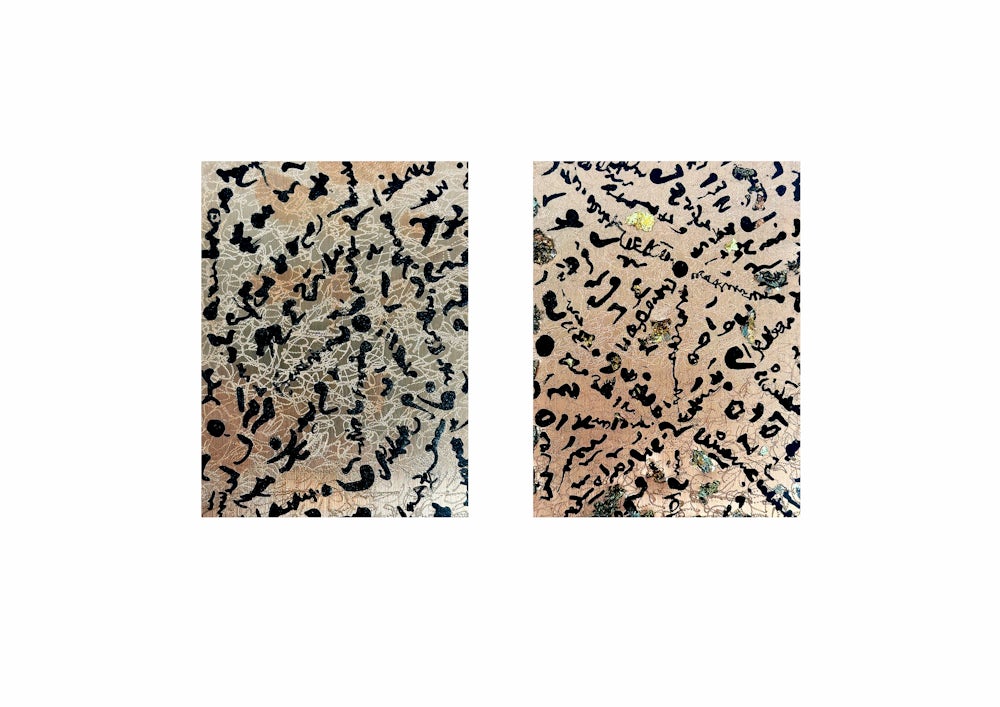Ecliptic Fragments delves into the nuanced interplay between memory, resilience, and rupture through the lens of copper and Chrysocolla, challenging and redefining the narratives of displacement and identity. This project delves into the liminal zones of borders, perceived as both fragile constructs and transformative spaces where control is challenged, and humanity endures. Employing asemic writing and a multilayered material approach, the work aims to provoke dialogue, foster empathy, and reclaim the silenced narratives of those displaced by borders.
The concept of borders as wounds—sites of historical violence, displacement, and resilience—is central to this project. Anchored in Frantz Fanon’s critique of colonial violence and Mirtha Dermisache’s asemic writing, this project examines how linguistic and cultural embodiments shape multilingual societies' identities. Primary research included conversations with individuals from Tuareg Maliian, Mauritanian, and Indonesian backgrounds met in a spiritual space, listening, capturing, and embodying their stories and the emotional resonance of living 'in-between' spaces. These encounters provided firsthand insights into the personal impacts of displacement and the resilience of cultural identities. Secondary research involved a comprehensive review of literature on decolonisation, border politics, and material symbolism in contemporary art. The project is artistically informed by Mona Hatoum's cartographic abstractions, Jill Magid and Taryn Simon's explorations of identity surveillance, and Maïa Tellit Hawad's innovative 'furigraphy', blending traditional and abstract gestural writings to navigate cultural memory and displacement.
Ecliptic Fragments reflects on the inherent failure of borders as stable, defining structures. The project posits that borders, often perceived as rigid demarcations of geopolitical and cultural identities, are instead fraught with contradictions and permeability. Through the medium of copper, which patinas and corrodes, the work symbolises how borders, like the material, undergo inevitable transformation and decay. This degradation illustrates the failure of borders to permanently contain or define the human spirit, revealing the gaps where resistance and resilience flourish.
The use of asemic writing across varied languages including Magic, Arabic, Hebrew, and Tuareg, challenges the very possibility of a singular, unified narrative. This linguistic interplay confronts the impossibility of fully capturing or conveying the complex experiences of those who live 'in-between' — between cultures, nations, and identities. The project underscores the limits of language and traditional forms of communication, pushing the viewer to engage with the visceral and the unsaid, thus navigating the terrain of what cannot be known or resolved. By embedding cosmological symbols in resin, the project creates a portal to the unknown — a space that invites speculation about ancient knowledge and the mysteries of existence that transcend contemporary understandings of borders. This aspect of the project draws viewers into a contemplation of the ancestral and the cosmic, areas filled with uncertainties and speculations. It juxtaposes the known material world with the unknown realms of heritage and the universe, provoking a dialogue between the seen and the unseen, the spoken and the silent. In framing these themes within the context of decolonisation, Ecliptic Fragments not only critiques but also transcends the colonial legacies embedded within the concept of borders. It invites viewers to reconsider the narratives imposed by these geopolitical constructs and to reimagine them as sites of creative defiance and transformative potential. This reimagining serves as a call to acknowledge and engage with the layers of history, memory, and prophecy that are often obscured by the apparent solidity of physical and ideological boundaries.

